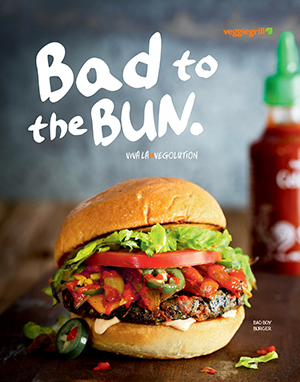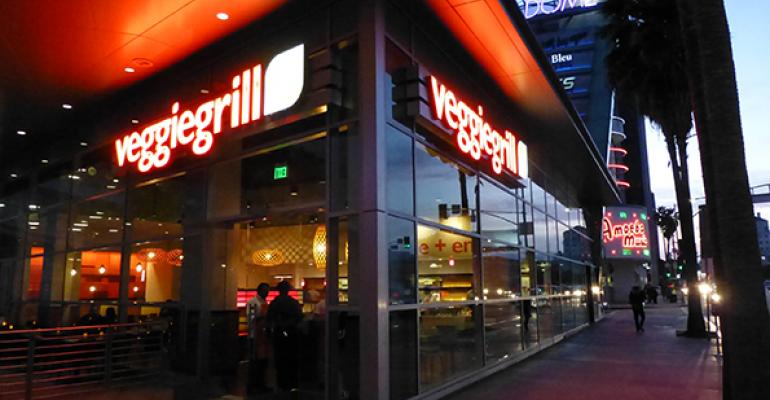Now 10 years old and with 29 restaurants, the Veggie Grill chain is rethinking its approach to growth.
Launched in 2006, Veggie Grill was one of the first concepts with an all-plant-based menu to make a run to become a national chain. The concept has earned the backing of private-equity firm Brentwood Associates and grown into three states: California, Washington and Oregon.
Now, as Veggie Grill contemplates moves away from the West Coast, the company is focusing on both developing urban locations and nontraditional licensed units on college campuses, healthcare facilities or airports.
A new sized-down prototype is in the works, and the chain is preparing for another investment round to plot out expansion to about 10 targeted markets, including major cities like Dallas, Chicago, Denver, Atlanta, Miami and the District of Columbia.

With consumers demanding less in the way of processed foods and more in the way of fresh ingredients and global flavors, even non-meat concepts like Veggie Grill have been forced to go even more “veggie positive” by moving away from meat analogs and more toward dishes like the Seoul Bowl, created by fine-dining chef Jet Tila for Veggie Grill, a twist on bibimbap with tofu that taps the increasingly popular flavor of gochujang.
Greg Dollarhyde, the Santa Monica, Calif.-based chain’s chief energizing officer, described in a recent interview with Nation’s Restaurant News how Veggie Grill’s menu has evolved over the past few years:
Can you give an update of where Veggie Grill is now?
I joined in 2011 and we raised some money. But at the end of 2012, we raised over $20 million for growth. Our comp store sales were up 15 percent that year. It was pretty much a rocket ride.
Then, as we went into 2013, we started sliding back into negative comps for a couple of reasons. There was menu fatigue. Also there was a big focus on our nutritional calorie count.
So in 2013 our sales dropped off and we had to rethink the menu. We did a lot of consumer research to find out what people really wanted out of Veggie Grill, and what they really wanted for their better-for-you diet.
I decided we needed to have different offerings on our menu that would be more whole foods and fresh veggies and things like that. So we introduced our bowl program in fall of 2013, and into winter of 2014. We also did things like included fries with our sandwiches. We started going after social [media] and the whole world of female promotion.

We hired the Culinary Edge out of San Francisco to work on the menu, and they developed things like our quinoa burger, which morphed into the Bad Boy Burger, which is a very spicy burger with Sriracha and jalepenos and this new cheese we import from Greece.
The addition of crispy cauliflower was a big win. Brussels sprouts have been hot. Kale is kind of played out. When I see something on Chick-fil-A’s menu, then I know I should probably move on.
So 2014 was a building year. We got customers back in to try new food. We bought that trial. But we didn’t discount to drive sales. We promoted to drive trial.
In 2015, we set the covenant with our guests as to what they wanted and what we were providing, and it really took off.
How did that impact same-store sales?
The good news was, in 2014 and 2015, we had low-single digit positive comp store sales. And for the first quarter of 2016, so far this year, we’re in high single-digit comp store sales.
Where are you with growth?
We are working on real estate, looking at both our urban and suburban locations. And we’ve decided that suburban locations are not for Veggie Grill. The investment is high, especially in Southern California, and the return doesn’t match the investment required for the rent.
We’ve seen bigger success in dense urban, but also urban with a strong entertainment and retail component, like Santana Row in Northern California, or University Town Center in San Diego or University Village in Seattle.
Your 29 units are all in California, Washington and Oregon. Are you looking to move away from the West Coast?
During the course of 2016, we cut back on almost all development. We built three stores. We wanted to slow down and rethink the how and where we want to go. We’ve seen some of our competitors go into markets and then close a number of stores.
Now we’re raising more money on an inside round with current investors and going toward a next stage of growth. We’re looking to leave the West Coast. I don’t really like the operating characteristics of California, with the minimum-wage pressure and on and on. The regulatory environment is challenging.
I’m not saying we won’t do more California stores, because we will. But we’re saying we will be very careful.
Do you see acceptance of plant-based dining in middle America?
Many people ask me if there are enough vegetarians to go to Veggie Grill. But 70 percent to 80 percent of any of our restaurants’ business is not vegetarian. We don’t expect you to come to Veggie Grill all the time. You’ll go have your fish sandwiches or burgers, but you’ll come to Veggie Grill on your rotation. We get people who just want to eat in the better-for-you space. This is a theme in America, now, I think.
They say, "make it better for me, but I don’t want to give up anything — except preservatives, and salt and trans fats. And don’t throw any pink slime in my food please." In our research, preservatives are a big deal.
We come to that with a unique offering. Not a lot of chains can say we just do veggies, fruits, grains and nuts. We are very innovative by using just the plant kingdom.
We call these people who are putting veggies at the center of the plates and celebrate this kind of eating as "veggie positive." Research we’ve done shows there are millions and millions of veggie positive adults in the U.S.
And we know where they live. They’re in Ashville, N.C., Austin, Texas, and Madison, Wis., yes, but also in the big cities. We’re going to find out where the best place is to put this in front of them.
If you told me five years ago we’d have a restaurant doing $2.7 million serving vegan food, I would have laughed.
That’s an AUV?
That’s for one of our stores, but that’s a number. We’re the largest, most successful vegetarian restaurant chain in the U.S.
Contact Lisa Jennings at [email protected]
Follow her on Twitter: @livetodineout





